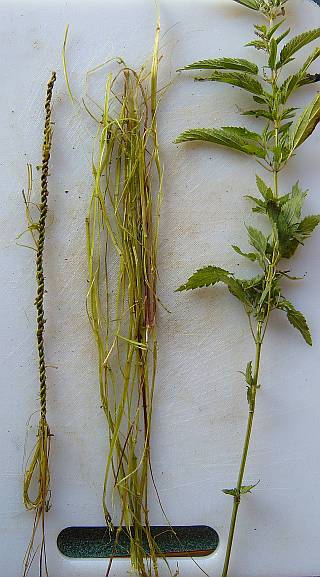 Nettles are high in vitamin C and A, as well as iron.
If nettles are boiled the water should be saved for an invigorating
tea especially if mixed with a little lemon and sugar.
Nettles are high in vitamin C and A, as well as iron.
If nettles are boiled the water should be saved for an invigorating
tea especially if mixed with a little lemon and sugar.
Stinging nettles (Urtica dioica) are found around wet meadows often near beaver dams, ponds and streams. The plants are tall (1+ meters) and typically unbranched. The leaves are paired on opposite sides of the stem, with an obvate shape and have sharply toothed leaf margins. The stems are four sided and fairly course. Small or minute greenish flowers are found in drooping clusters from the axils of the leaves. The plants are covered with stinging hairs (called trichomes) that break into a needle when touched and inject a variety of irritants. The reaction from touching or brushing against the plant will be almost immediate and last from 5 to 30 minutes (in some cases longer). Dried, or even wilted, plants usually no longer cause a stinging sensation.
Young stems and leaves can be steamed or quickly boiled to make a nice cooked green. The collected portions of the plant should be quikly cooked - often adding nettles to boiling water then straining almost immediaately is enough. Older leaves may need to be boiled for a little longer. Served with alittle lemon and butter nettles make a nice addition to any meal with a flavour similar to spinach.
 Nettles are high in vitamin C and A, as well as iron.
If nettles are boiled the water should be saved for an invigorating
tea especially if mixed with a little lemon and sugar.
Nettles are high in vitamin C and A, as well as iron.
If nettles are boiled the water should be saved for an invigorating
tea especially if mixed with a little lemon and sugar.
Fibers from the older stems of nettle plants can be separated and used to make a fairly strong cord - similar in strength to hemp or flax. The outer 'bark' of the nettles contains fine long fibers. The best method for collecting the fibers involves collecting the plants in the fall (after a frost) and drying the stems before extracting the fibers. It is also possible to extract fibers from fairly fresh material; this is the method we will use at Mantario.
Collect a number of older nettle stalks (save the young tops/shoots for eating later). Crush the stalk with your fingers and split them down one side or in half/quarters. Separate the inner pith from the outer fiberous 'bark' by rolling the outer layer back across your fingers. The fibers can further be separated out of the 'bark' by rubbing the material between your palms in water. Allow the bundles to dry at least a bit before making any cord.
Divide the fibers into two equal bundles and knot the end. Hold the knot in your left hand and roll (or twist) the bundles separately clockwise between your fingers or along the side of your leg. Let go of the knotted end and the fibers will re-twist together. You may have to 'help' the re-twist a little. I have found holding the knotted end and reverse twisting (counter clockwise) the loose ends of the fibers also works well. Hold the bottom of the newly twisted cord and roll the fibers again, repeat, repeat. Add additional fiber as necessary by rolling new fiber lengths into the cord. Remember to keep the two fiber bundles the same size. It is much easier to have someone else hold the end of the cord but that makes it a two person job - a good bonding type of activity.
An alternative to knoting the starting end is to take a single fiber bundle and twist it until it forms a 'kink'. Fold the bundle back on itself at the kink and that will be the start of the new cord. Continue to twist and add more fiber as above. This method makes a very nice clean end of the cord.
Wood or false nettles (Laportea canadensis) found in moist shady riparian woodlands can be eaten and used for cordage just as stinging nettles. Some people feel these nettles make better cord.
Some resources:
- Wikipedia on Nettles
- Making cordage
- More making cordage
- Even more cordage